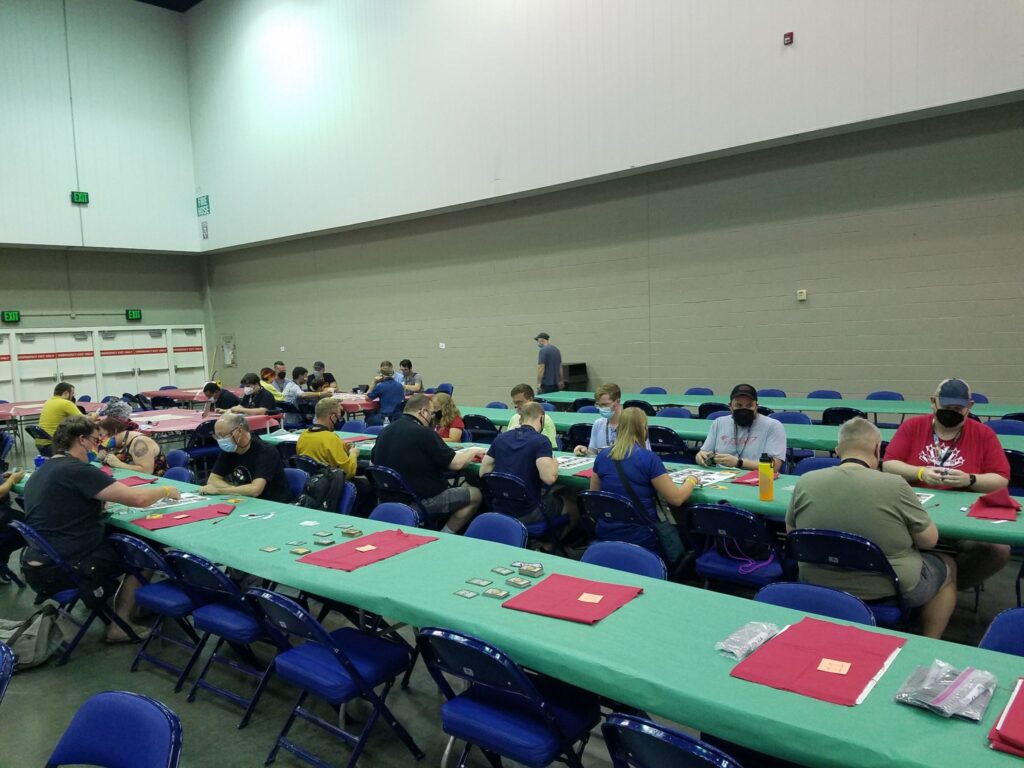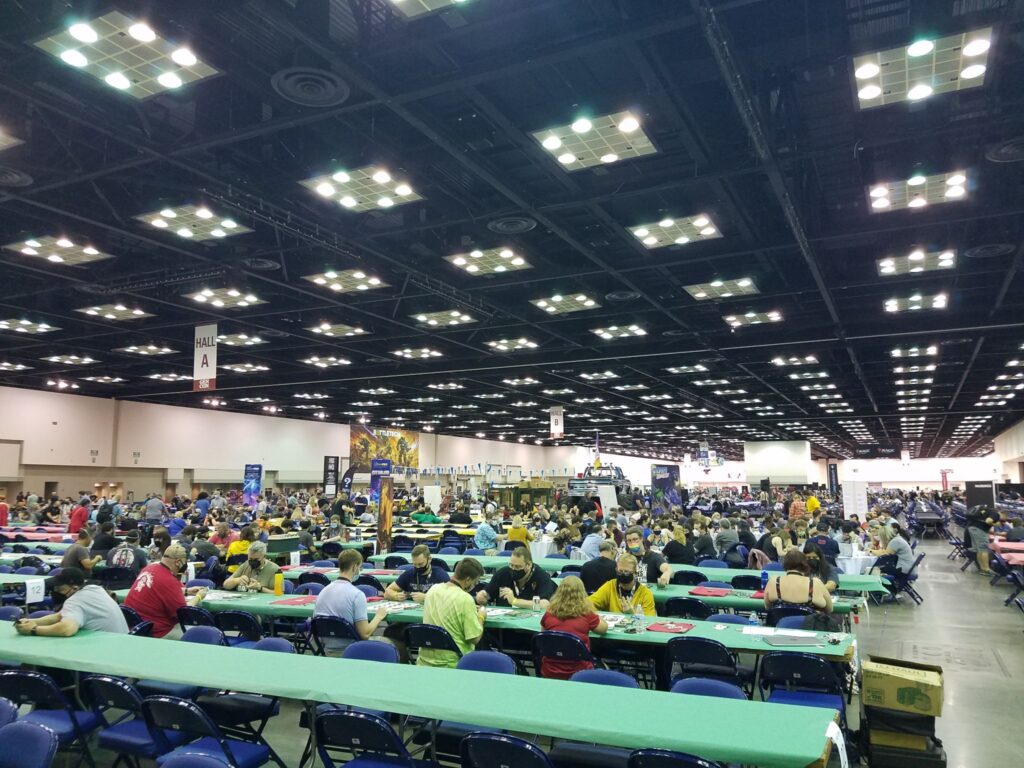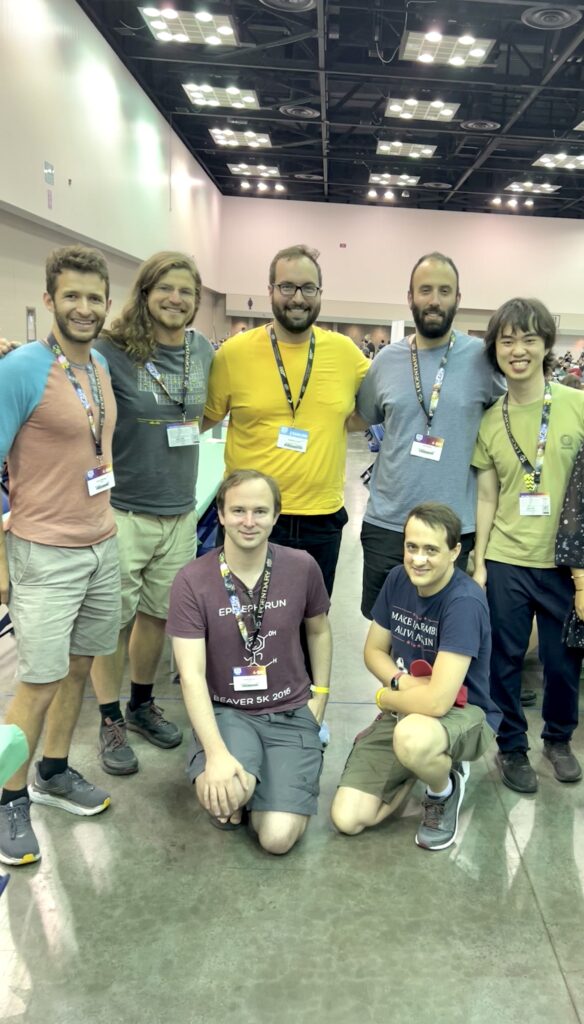
The Dominion Galactic Championship was held this past weekend at Gen Con in Indianapolis, IN. The tournament and the whole experience was unlike any of the other tournaments I’ve run in the past, and I’m glad I put this tournament on and went through the process of running a tournament at a convention. We had 48 entries in the tournament and had a deserving winner, Eugene Lee AKA ceviri.
I’ve attended Dominion tournaments at conventions before, but all of the tournaments I’ve run up to this point were standalone events. I’ve had people ask me what it’s like to run a Dominion tournament at a convention and I’ve also wondered myself what it would be like, and this was the time to find out. I’ll be making a separate post about what I’ve learned from this experience as a tournament organizer, to add to those resources, but I’d like to list a few of the big takeaways here that were more relevant to this specific tournament.
– It’s hard to promote your tournament when you’re running it at a convention. Thankfully, the fact that you’re part of the convention is its own promotion in a way. People are usually coming there for the convention and your event will be seen by a huge amount of people who don’t have to make a huge commitment to play in your tournament. There’s not much doubt that you will probably get more people to attend your tournament with less promotion work if you’re part of a convention. This is the largest tournament I’ve ever hosted by a significant margin — larger than I would be able to do without a convention setting.

– If you’re having trouble finding a venue for a standalone event, a convention will solve your problem. You’ll have the table space you need to have a tournament as large as you want, in a space suitable for gaming.
– You’ll end up doing more work jumping through the hoops you need to work with the convention regarding scheduling, entry fees, and whatever other rules the convention places on you. You’ll also usually have to buy a convention badge in order to run a game there, so you’ll be paying money to run your tournament as opposed to most venues which will be happy to just have a cut out of your prize pool.
– You’re more likely to have players who are much newer to the game in attendance, so you may want to take some steps to make your tournament more beginner-friendly.
For me personally, after this experience, I think I’ll be focusing again on standalone events in the future — I’m lucky enough to have multiple good venue options near me and I’ve already established a legitimate network to help promote my events, and I appreciate the extra flexibility I have to work directly with a venue.
It’s possible that I’ll run another tournament at a convention some day, but if I end up doing that, it will be at a different convention (not Gen Con). If that happens, I’ll be changing the name of the tournament, so I can confidently say that our first and only Dominion champion OF THE GALAXY was crowned this weekend!
All right, enough of that, let’s talk more specifically about the tournament. This one was a bit different in format because I wanted to be able to have a lot more people be able to play if they wanted to. There were four qualifier rounds throughout the convention, and players who survived their qualifier were invited to the finals at the end. It’s a bigger time investment for me but it allows for up to 128 entries and for people to enter multiple qualifiers if they want to.
The format was a giant double elimination tournament — last as long as you can before you lose twice. The longer you last, the higher your placement, and the more money you’ll win from the prize pool (if you make it far enough). The last one standing is called the champion. All games were two-player games, so it’s possible for a player to have a bye round, where they are either matched with an opponent who has already been eliminated, or just given a win if no such opponent can be found.
Here’s a link to the spreadsheet containing all of the kingdoms used for this tournament.
I’ll take a moment now to talk about the four kingdoms I designed for the later stages of this tournament.
Finals Kingdom 1: Hunting Lodge, Miser, Hamlet, Island, Cultist, Witch, Swindler, Barbarian, Experiment, Rats; Seaway, Tomb
The intent here was to have awful decks with so much junk in them, that Rats as the only trashing plus Tomb improves your deck to the point where the pile control you get (especially if you Seaway them) plus the immediate VP from Tomb and the synergy with trashing Cultists is strong enough that it’s game-decisive, even if you have more junk than your opponent. A lot of playtesting went into this kingdom which has so many cards from the banned list present, and I had the experience I wanted a few times during playtesting.
Unfortunately, the version of this kingdom where I tested the direct Seaway/Rats deck (aiming to 3-pile Coppers, Curses, and Rats) was done before Ruins were in the supply, and while that “degenerate” deck wasn’t fast enough to beat a Miser-focused deck that uses Hunting Lodge, the Ruins allow the Seaway/Rats deck to end the game too fast and with enough points for anything else to get going.
One of the games played in the tournament ended up being a Seaway/Rats mirror, which fortunately was interesting enough, but it wasn’t what I was going for. I’m not quite sure how to fix that problem other than to replace Seaway with something else, but this is the board that was played in the tournament.
Finals Kingdom 2: Royal Carriage, Festival, Forager, Tactician, Priest, Candlestick Maker, Legionary, Mystic, Squire, Tunnel; Pathfinding
The intent with this kingdom was to build a deck where you put Pathfinding on Tactician, then call Royal Carriage on Tactician to activate multiple Duration Tacticians in a turn. Nothing else you can do here will increase the number of cards in hand, and the explosive payload of Priest gives enough reason to justify jumping through these hoops.
This game was played one time during the tournament, and neither player saw the multiple-duration-Tactician deck, opting to play a more “standard” double-Tactician deck with Pathfinding+Candlestick Maker as payload.
Finals Kingdom 3: Tiara, Bridge, Vault, Chapel, Stonemason, Villain, Altar, Bureaucrat, Bandit, Trader; Gamble, Bandit Fort
Bandit Fort stifles most money decks you can build here, with the possible exception of using lots of Vaults and few Golds. There is a powerful megaturn deck here, though, that uses Gamble and Bridge at its core. The deck thins with Chapel aggressively, gets a single Altar, a Villain or two, a few Vaults, and then aims to add Bridges quickly using Stonemason (aided by the cost reduction from Bridges) and Altar. Your turns should look like this: play a Vault, discarding everything in your hand, and start Gambling. You can use stored Coffers from previous turns to make sure you can play all the cards in your deck using Gamble. Without being attacked, this deck can consistently empty Provinces on turn 12 or 13 while Playing Villain at least once on most turns after the first 6-7.
This kingdom was played twice at the tournament, both times with one player going for the Gamble/Bridge deck and the other playing a simpler money density deck. Each deck won one of the games, but the Gamble/Bridge deck that won used Bandit to gain Golds, which served as the deck’s draw instead of Villain. This is an interesting variant on the deck I intended, with a few differences:
The Bandit deck doesn’t rely so much on starting each turn with a Vault, so it doesn’t have to be as thin and pick up extra Vaults for consistency.
Action cards drawn in the starting hand can’t be played unless the opponent plays a Vault consistently on their turn — there are enough Golds in the deck that a single Vault play usually does the job. That was the case in this game, but I question if this deck would be viable against an opponent who stopped playing Vaults and pivoted to a Gold flood to combat this strategy. The Bandit attack probably hurts a Vault-based money density deck about as much as Villain’s attack does, but potentially does less against the gold-flood pivot.
Having a large number of Golds is a significant amount of negative points from Bandit Camp, which is a liability if this deck allows the opponent to get enough Provinces before the megaturn. However, it can potentially enable some better turns in the midgame because you don’t have to try and save your Coffers for a megaturn.
Are these tradeoffs worth it? I’m not sure, I’d have to playtest it more. My gut says that Villain out-performs Bandit in the megaturn deck but I can’t be sure.
Finals Kingdom 4: Bank, Coin of the Realm, Astrolabe, Market Square, Transmogrify, Catapult/Rocks, Secret Passage, Throne Room, Haven, Crystal Ball; Canal
I actually had a different version of this kingdom finished before Seaside and Prosperity’s second editions were released, but then Astrolabe and Crystal Ball fit so much better into this kingdom than Scepter, I was really happy with the way this kingdom came alive and featured two of the newest Dominion cards.
Bank is great here with tons of enablers, but the only thing here resembling draw is Haven and there’s also Catapult, so you’re looking for ways to squeeze as much value out of your deck as possible to put into your Banks. You have Transmogrify and Market Square to help you gain Banks easily, you have Crystal Ball which helps you get thin quickly, then turns into effectively a cantrip with lots of money on it in your Buy phase, you have Secret Passage to help ensure that your Banks are the last treasures you play, Astrolabe and Coin of the Realm (easily gainable with Canal/Transmogrify if you have extra Coppers or Curses around), and Haven can help you bring cards from previous turns to give you bigger turns.
This kingdom was used for the tournament finals, which were recorded on video. I’m pretty happy with how it turned out.
I’ve been running Dominion tournaments since 8 years ago, this is my thirteenth tournament. I’ve put a lot of work into each one, and a lot of work into constantly improving the way things are run, both for the benefit of the players and for my own benefit. I’ve also put a lot of work into promoting my tournaments and establishing a network where people can find tournaments like mine not only in the Midwest, but reaching out to people who are willing to travel even farther just for an event like this. My beginnings were humble, and no part of getting to where I am today has been easy, especially given the last two years.
Both tournaments I’ve run this year have had people there who heard about them through my promotion and networking — people who love the game are able to find a place to play the game they love, face-to-face, with other people who feel the same way. Every time I give this experience to another people or group, I’m reminded of when I had that experience for the first time, and also of the friendships I’ve made with people because they showed up to my tournaments in the past. It’s so validating to see more and more people show up to this because of the other people in the past that have had positive experiences. It’s not often that you get to directly see the results of your hard work.
On top of this, there was a sizeable group from the online community that travelled to Gen Con because the tournament was happening, and got to meet up in person. Many of them travelled from across the country for this, and I was specifically told that it wouldn’t have happened without the tournament. It’s another instance of that validation I was just talking about, but this one went a few levels deeper.
My relationship with the online community informally ended many years ago, and it was not on good terms. There is still bad blood between myself and the other people involved, and it is for that reason that I didn’t have any expectations of interacting with the online group, beyond knowing to watch them closely because I expected them to play well and make it far in the tournament.
The tournament finals came, and this is when that online group planned to all be at the tournament to hang out and hopefully also be playing in the tournament. They had come together to somehow find a Hinterlands 2E Update Pack (which I had not been able to find in time for the tournament) and gift it to me as a thank-you for organizing the tournament, which was such a nice gesture by itself, but they were nice and welcoming to me as a part of their group whenever I had downtime during and after the tournament. It was such a positive experience for me and it meant a lot that they would be as welcoming and thoughtful as they were.

I’m not sure if it’s the fact that I had entered with such low expectations of how that interaction might go (which was not justified, by the way — none of these people had anything to do with any of the stuff that caused me to leave that community), or the fact that most people, especially me, have been so starved for real, in-person human connection over the last two years. But I really enjoyed this group of people and I was really happy them came to the tournament, it was way beyond what I thought could happen. It’s making me rethink my position of not wanting to be “a member of the online Dominion community” after many years of being glad I wasn’t.